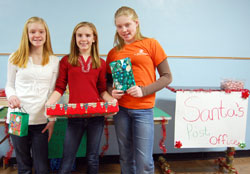Paying it forward:
Students’ random acts of kindness offer lesson of thinking beyond yourself

Sixth-grade students at St. Mary School in Greensburg have focused on doing random acts of kindness in their school and community during this school year. Bailey Schroeder, from left, Kasey Moeller and Maddy Schroeder led an effort among their classmates to raise money for a family in need at Christmas. (Photo courtesy of Greensburg Daily News)
By John Shaughnessy
The confused look undoubtedly came first, followed by the flashing of a smile that likely reflected this thought: “What a terrific thing to do.”
The special moment happened in the drive-thru lane of a fast-food restaurant in Greensburg, a small community southeast of Indianapolis.
As a mom rolled down her car window to pay for food for her and her son, the boy suddenly remembered a project that has been a key focus for him and his classmates in the sixth grade this year at St. Mary School in Greensburg.
The project encourages the 27 students in the class to do random acts of kindness—with no expectation of receiving any recognition or compensation in return.
So the sixth-grade boy asked his mother to ask the drive-thru cashier how much the food bill was for the people in the car right behind theirs. When the boy was told the amount, he pulled $5 from his pocket to pay for the strangers’ bill. He also had his mother pass to the cashier a card—a card that he wanted the cashier to give to the driver in the car behind theirs.
The front of the card, which had been specially made for the sixth-grade students, read:
YOU’VE BEEN RAK (RANDOM ACTS OF KINDNESS) ATTACKED!
The card included the name and address of the school and asked the recipient to share a random act of kindness with someone else.
Taking the money and the card, the cashier looked confused at first, then she smiled—which likely matched the reaction of the person who received the card and the free food.
“One of the neat things about this project is that it has awakened the students to the needs of others,” says Nancy Buening, the principal of St. Mary School. “Some of the kids have made baked goods and taken them to people—sometimes secretly—and left them on a porch with the RAK card on them. Around Christmas, the students helped a former St. Mary family who had lost a loved one. They raised more than $800 to help the family.”
Kindness is contagious
The idea for the project began during the summer when St. Mary fifth- and sixth-grade religion teacher, Laura Domingo, met with the school’s counselor, Lacey Rentschler.
“Our school is through sixth grade so I wanted to do something that would leave one big lasting impression on the students as they move forward to being adults,” Domingo recalls.
“We kicked the project off during the first week of school by showing the movie Pay It Forward. And we talked to the students about the challenge of recognizing others’ needs, not just our own. I told them this would be difficult, we would have ups and downs, and some of them would think it was dumb, but we were asking them to step up to the plate to join forces and make a difference.”
Most of the students have made the commitment. They have raked leaves during the fall. A group of girls noticed the Christmas song books at their school were coming apart, so they made 200 new books—typing, binding and laminating each one. One boy has secretly scraped ice from the windshields of cars in his neighborhood, leaving a RAK card under the wiper.
The back of the card notes, in part: “If you got this card, it means that someone has done a RAK [Random Act of Kindness] for you. We ask that you do a RAK for someone else. . . .We believe that kindness is contagious—and it all starts with you!”
With each act of kindness, the students have become more involved and more affected by the project.
“I didn’t realize that a couple little cards could change your outlook on the whole world around you,” says Nicole Ploeger, one of the sixth-grade students. “I’m going to stick a $5 gift card with a RAK card in someone’s mailbox.”
Classmate Brandon Butz notes: “I think RAK is making a difference because at school and in our community there are people being nicer.”
Regan Horan has noticed the surprised, pleased looks on people’s face when they are the recipients of a RAK Attack. Kelly Meyer has noticed the difference the project has made to her: “[It’s] making me think and act a lot kinder.”
The lesson of thinking beyond yourself
The students’ response to the project has challenged their teachers and parents, too.
“When I got my first card, I thought, ‘What am I going to do?’ ” Domingo says. “I prayed about it. At church one day, a grandmother approached me. She told me her son had become a single parent and he had three kids, including twins. I also have twins. She was looking for hand-me-down clothes. I went through the closets at home and put together three bags of clothing and toys for her grandchildren and dropped them off at her house. I stapled a RAK card to it, and asked her to pay it forward.”
The random acts of kindness project will continue in the second half of the school year with a new twist.
“Our next challenge is to give each sixth-grader one dollar and challenge them to make a difference with that dollar,” Domingo says. “They can pool their money or do something small with it to make a difference.
“We’re trying to show the students how they can make the world a kinder place. It’s helped them treat their classmates kinder, too. They’re thinking beyond themselves to see what they can do for others.” †
